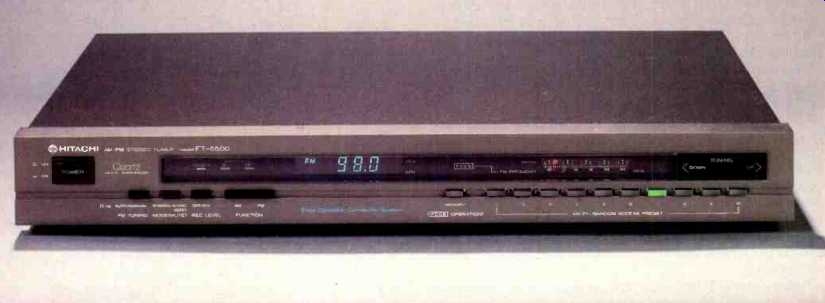
Manufacturer's Specifications
FM Tuner Section:
Mono Usable Sensitivity: 10.8 dBf.
S/N: Mono, 85 dB; stereo, 78 dB.
Frequency Response: 20 Hz to 15 kHz, ±0.5 dB.
Selectivity: Wide mode, 45 dB for ±400 kHz; high-selectivity mode, 65 dB for ±300 kHz.
Image Rejection: 80 dB.
I.f. Rejection: 95 dB.
AM Suppression: 65 dB.
Capture Ratio: 1.0 dB.
THD at 1 kHz (Wide Mode): Mono, 0.04%; stereo, 0.06%.
Stereo Separation: 60 dB at 1 kHz.
Output Voltage: 550 mV for 100% modulation.
AM Tuner Section:
Sensitivity: External, 12 µV; loop, 250 µV/m.
Image Rejection: 50 dB. Selectivity: 50 dB. S/N: 54 dB.
I.f. Rejection: 40 dB.
Output Voltage: 165 mV, 400 Hz, 30% modulation.
General Specifications:
Power Requirements: 120 V, 60 Hz, 9 watts.
Dimensions: 17 1/8 in. (43.49 cm) W x 2 3/8 in. (6.03 cm) H x 12-1/16 in. (30.63 cm) D.
Weight: 8.8 lbs. (3.96 kg).
Price: $350.00.
It doesn't seem all that long ago since you had to pay well over $1,000 to buy a true frequency-synthesized FM tuner that could be electronically tuned with crystal-controlled accuracy and could "memorize" a few of your favorite stations for touch-button recall. Yet here we have a neat, slim FM/AM tuner from Hitachi costing a fraction of what such a unit would have cost five years ago and incorporating additional circuit refinements that no one would have dreamed about back then.
The most interesting of these new circuit features is called F.C.C.S., which stands for Field Condition Computer System. The microcomputer governing F.C.C.S. operation performs the following: (1) After first lighting an indicator to show that it is in operation, it performs a computer search to determine whether or not any adjacent station is preset which might interfere with the desired station. In addition, it searches further (in frequency) to determine whether or not any station which can cause r.f. intermodulation interference is present. (2) It sets the r.f. and i.f. selectivity modes in accordance with the results of the search. (3) When the settings are complete, the system memorizes both the frequency of the desired station in one of its preset memories and the settings of r.f. and i.f. selectivity for that particular preset station. The next time the station is called up by means of one of the preset buttons, it is not only tuned to with frequency accuracy, but with optimum selectivity settings for the r.f. and i.f. stages of the tuner.
Front panel controls include a power switch at the left, FM tuning, FM mode (mute), record level (activating an internal tone for presetting tape recorder levels) and an AM/FM selector switch. Further to the right are the memory switch (which also functions as the F.C.C.S. operation switch), 10 preset buttons for memorizing as many favorite FM and AM stations, up and down tuning keys, a signal strength meter, and, of course, the digital frequency display associated with frequency-synthesized tuners. To the left of this display are three more indicator lights which display high-selectivity r.f., high-selectivity i.f., and stereo reception when any of these modes is active.
At the left of the rear panel is an AM channel spacing switch with positions for 9 or 10 kHz. Until recently, it had been thought that countries of North, Central and South America would join in favoring a 9-kHz AM channel spacing, the practice of much of Europe and Asia. However, such a change was indefinitely postponed at a recent international meeting, so the countries of the Western Hemisphere will continue to use 10-kHz spacing between AM stations. Still, having this switch on this and some other tuners we have seen will allow you to properly tune in AM stations in other parts of the world if you should relocate to areas where 9-kHz spacing is used. (Of course, in that event, a step-down transformer would be needed for the U.S. version of this tuner, since those countries also use 220/240 volts a.c. instead of 120 volts.) A coaxial 75-ohm FM antenna connector, a ground terminal, terminals for connection of an external AM antenna, a built-in "loop" AM antenna, and a pair of output terminals complete the rear panel layout of the FT-5500 tuner.
Measurements
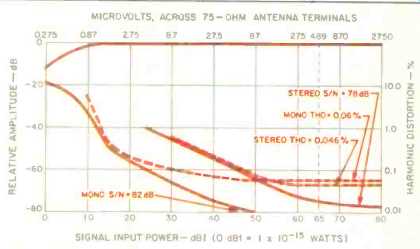
Fig. 1--Mono and stereo quieting and distortion characteristics, FM section,
Hitachi FT-5500 tuner.
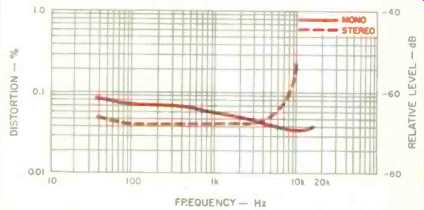
Fig. 2--Distortion vs. frequency.
Usable FM sensitivity for the FT-5500 in mono measured 11.0 dBf. Since there is only a 75-ohm input on this tuner, that translates to 0.98 µV (which is a good illustration of why we now quote sensitivity figures in terms of power rather than voltage; dBfs are the same regardless of input impedance). Stereo sensitivity was governed not so much by the r.f. and i.f. sections of the tuner as by the threshold setting at which reception switches automatically from mono to stereo; this setting was at 24 dBf for the sample tested.
Fifty-dB quieting in mono was obtained with a signal strength of 14.2 dBf, while for stereo, the reading was 35.3 dBf. Since I was dealing with single-generator measurements in all of these tests, the tuner was automatically working in its "normal" r.f. and i.f. selectivity modes. Signal-to-noise ratio in mono, with a 65-dBf signal, measured a very high 82 dB, while in stereo I obtained a reading of 78 dB, exactly as claimed by the manufacturer. Both of these S/N readings are excellent for any tuner, let alone one employing frequency synthesis (which, until recently, had a tendency to compromise S/N results in return for accuracy of tuning). Quieting and mid-frequency harmonic distortion characteristics are shown in the graphs of Fig. 1. THD for a 1-kHz, 100% modulating audio signal measured a very low 0.06% in mono and an even slightly lower 0.046% in stereo.
Twin-tone IM (using 14and 15-kHz signals) measured less than 0.05% in mono and less than 0.1% in stereo.
Harmonic distortion as a function of modulating frequency, plotted in Fig. 2 for stereo and mono reception, remained well below audibility levels at all relevant frequencies in both modes. I should point out that this is the first tuner I have tested with the aid of the Sound Technology Model 1020A FM Generator. This instrument allows measuring FM distortion fully one whole order of magnitude lower than was possible with the Model 1000 generator, which could only guarantee THD readings down to 0.1%. In other words, I now have the capability to read FM tuner THD down to as low as 0.01%! Another new capability afforded by this generator is its ability to evaluate a tuner's SCA rejection capability in accordance with IHF (now EIA) standards. That is, not only must there be a 67-kHz subcarrier signal modulating the main carrier to the extent of 10%, but that subcarrier must, in turn, be modulated with an audio signal of 2.5 kHz, to a deviation (of the subcarrier) of ±6 kHz. The new generator provides such a signal, and, for the Hitachi FT-5500, SCA rejection measured a high 71 dB. Figure 3 is a spectrum analyzer plot of frequency response (upper trace) and stereo separation versus frequency for this tuner. Separation measured 58 dB at 1 kHz, 53 dB at 100 Hz, and 42 dB at 10 kHz. Frequency response was well within the published limits (± 0.5 dB) from 20 Hz to 15 kHz. AM suppression measured 65 dB as claimed, while i.f. rejection and image rejection were both higher than claimed, with readings of 100 and 87 dB respectively. Capture ratio measured exactly 1.0 dB, as claimed.
It was only when I began to measure selectivity that I was able to "force" the tuner into its high-selectivity modes. The micro-computerized F.C.C.S. system interpreted the second generator signal as an interfering signal (which, indeed, it was in these tests) and "flipped" the circuitry into its alternate high-selectivity mode. Under these conditions I measured a selectivity of over 80 dB (for 400-kHz spacing). I'm not sure how Hitachi measures the "normal" selectivity values, unless they use the single-generator method to plot r.f. and i.f. response directly, on a point-by-point basis, since any attempt to use two generators throws the system into the high-selectivity mode (as it should). Figure 4 shows the crosstalk and distortion components arising in the output of the unmodulated channel when a 5 kHz signal (tall spike at the left of the display) is used to modulate the opposite channel. While 19and 38-kHz components are fairly large (the two components near the center of the display), other crosstalk components are quite small and separation at 5 kHz (as measured by the difference in amplitude between the tall spike at the left and the shorter spike contained within it) is around 48 dB. Vertical scale in this display is 10 dB per octave.
Figure 5 is a plot of frequency response of the AM tuner section. The FT- 5500's AM tuner section was better than most as far as fidelity is concerned, with useful response extending up to beyond 4 kHz. Note, too, the "notch" filter action at around 10 kHz-an added circuit which, unfortunately, all too few AM tuner designers incorporate into their products these days.
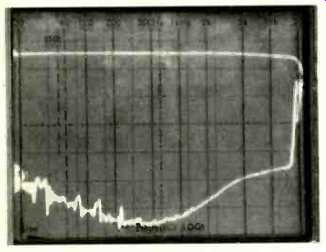
Fig. 3--Frequency response (upper trace) and stereo separation vs. frequency;
sweep is logarithmic, from 20 Hz to 20 kHz.
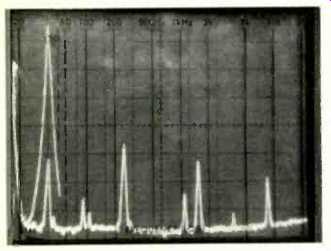
Fig. 4--Crosstalk and distortion components of 5 kHz, 100% modulated signal,
left channel only. Horizontal scale is linear from d.c. to 50 kHz.
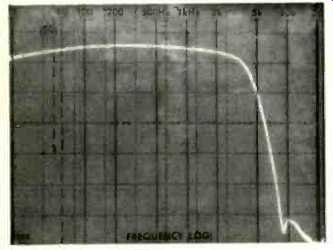
Fig. 5--Frequency response, AM tuner section. Sweep is logarithmic, from 20
Hz to 20 kHz.
Use and Listening Tests
The Hitachi FT-5500 performed extremely well, offering noise-free performance on all the stations I normally expect to receive. Stereo threshold might have been set a bit lower since, by the time stereo switches in, signal-to-noise is already 40 dB or better. The same holds true for the muting threshold, which is set: at around the same 24-dBf point as the stereo threshold. Still, from a practical point of view, if you use an outdoor FM antenna (as indeed this tuner deserves), you should be as pleased as I was with the clean, noise-free, accurate signals delivered by the FT-5500. One interesting final note: The FT-5500 switched over to its high selectivity mode (thanks to the action of the F.C.C.S. system) only for two stations in my area. One was a local, low power station that was only 200 kHz from a more powerful metropolitan area station; the other was a fairly powerful station that was 400 kHz removed from another strong station. Frankly, even in the high-selectivity modes that resulted, I couldn't detect any significant increase in distortion, nor did separation seem to suffer. All in all, a cleverly designed and very well-built tuner at a price that makes it affordable for a great many people who are serious about high-quality FM reception.
-Leonard Feldman
=================
(Source: Audio magazine, May 1982)
Also see:
Hitachi DA-600 Compact Disc Player (Feb. 1985)
Hitachi Model SR-2004 Stereo AM/FM Receiver (Equip. Profile, Nov. 1978)
= = = =